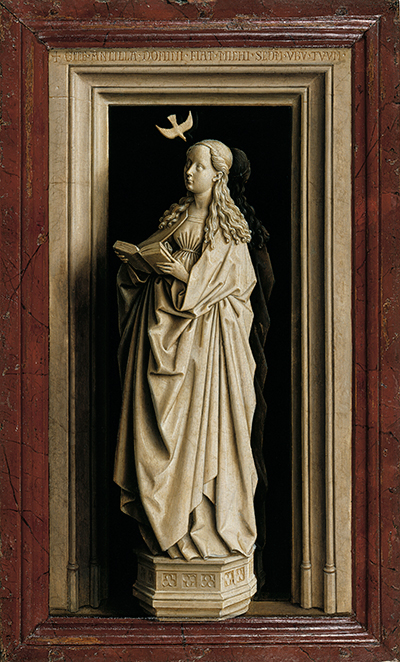This painting is one half of the Diptych of The Annunciation that Jan van Eyck completed between the years 1434 and 1436
The lady pictured here sits on the right hand side of this two-sided artwork, with the matching gentleman of the annunciation found here. As with all diptyches, the two panels are sized the same so that the finished piece is entirely symmetrical. This differs slightly from three-sided triptyches, where the central painting is normally twice as wide as the adjoining panels and holds a greater significance over them.
More elaborate multi-panelled pieces would require the artist to paint both sides for when it is opened or closed. That was possible with small hinges on either side of the central panel though in the case of Jan van Eyck's Diptych of The Annunciation, there were no hinges and it was completed on just one side with the two matching portraits.
Jan van Eyck was an artist who placed particular importance on the frame surrounding the painting and would sometimes actually paint it himself in order to make sure that it matched the painting seamlessly. Many of these frames have since been damaged or even lost completely but you can see in this artwork how he paints a inlay frame and inscribes letters upon it.
The period in which artist Van Eyck was prolific was also the most popular time for diptychs, with several other local names also producing art in this format, such as Hans Memling, Rogier van der Weyden and Hugo van der Goes. Another member of the Northern Renaissance, Hieronymus Bosch, created the finest triptych of them all, in The Garden of Earthly Delights.
The full diptych in relatively small for a multi panel piece, suggesting it was commissioned with the sole intention of private worship, without ever any intention for it to be placed on public display. Thankfully, the art world has fully embraced the majesty of Van Eyck's career and ensured that his work has been snapped up by major public art galleries and museums across Europe, enabling us all to enjoy these works today.
The two panels feature the Archangel Gabriel on the left hand side and the Virgin Mary on the right, as shown in this page. They wear similar attire and stand on identical platforms. Van Eyck's Ghent Altarpiece features a very similar use of the two in its much more complex series of panel paintings.




